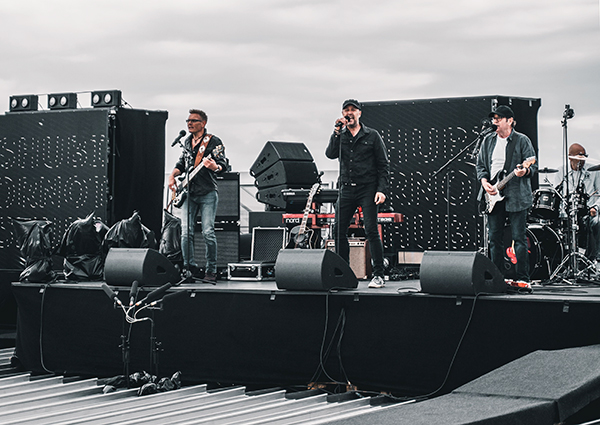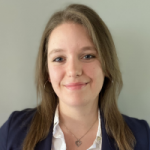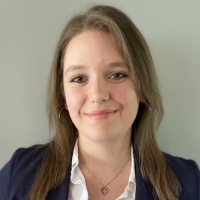While most live events are canceled or indefinitely delayed, it hasn’t stopped some clever folks from bringing the music to the masses. I’d like to introduce you to “Covidhagen,” a recent 24-hour livestream concert/festival originating from the roof of the Copenhagen Opera House and presented on the Twitch TV platform.
A rock-star group of professionals from production company DPA Soundco (based in Coppenhagen) curated the non-stop musical event to replace Denmark’s beloved festival season. Audio engineer Ally Kerslake, the project manager for the ambitious event, dealt with more than 50 acts, some with multiple personnel, in the round-the-clock show on a roof that’s accessed via a small elevator and an even smaller stairway.
“This was only the second time an event had been staged on the Opera House roof,” Kerslake notes. “The first was the Red Bull cliff diving event in 2018, where we also designed and supplied the audio solution, so having been chosen again, we knew the kinds of challenges we’d face. Safety was a key concern, both in terms of Covid-19 and the access issues.”

Teams worked in two 12-hour shifts, with each team consisting of an audio project lead, broadcast mixer, monitor mixer, two alternates for breaks, an RF/stage A1, a stage/system A2, stage alternates, and an audio trainee. Atop one of Copenhagen’s most iconic sites, an entire production was born. (I don’t even want to imagine the ordeal of loading in and out on a roof with little access.)
To help keep things efficient, the stage, microphones (including wireless mics and personal monitors), amplifier racks and monitors/cue wedges lived on the roof, while the control room was positioned inside the Opera House on the second floor. Direct camera-fed program on video monitors was given to each of the mix operators so they could get a feel of what was happening several floors up on the roof.
Familiar But Different
As noted, more than 50 acts graced the Covidhagen stage, most of them musical artists (of course). The team at DPA Soundco employed 25 Shure Axient handheld wireless transmitters and 20 PSM 1000 personal monitoring packs. Frequency coordination of all of these systems (plus the media wireless systems) were handled with an assist from Shure Wireless Workbench.

The hub of “wireless world” was a workstation manned by the RF techs where this gear (and more) resided. It was also equipped with a full disinfection set-up, with dedicated windscreens for each artist member and all IEMs and transmitters were thoroughly cleaned/disinfected between uses. (The RF techs handled this aspect as well.)
The fact that the audience for the event would be at home rather than on the Opera House roof meant that there was no requirement for a traditional main PA. Instead, the need for an extremely solid monitor solution was one of Kerslake’s top priorities.
“The stage was situated on the center roof section of the Opera House,” he explains. “It was effectively a blank canvas in terms of planning, because there had never been a concert style production up there. We knew there wouldn’t be a stage roof because of building regulations and no chance of a usual monitor mixing position.”
With the consoles for monitoring and broadcasting located below, inside the main building, with performances watched on a screen, and the nature of the event demanding five-minute turnovers, everything took on the air of a festival rather than a TV production.

DPA Soundco positioned six biamped CODA Audio CUE TWO stage monitors across the front of the stage, with a CODA APS “booth” system to serve the many DJs who performed. This consisted of a single APS-SUB and three APS per side. The team also used a stereo system of CODA SCV and HOPS8 for broadcast reference monitors as well as a further pair of CUE TWO as listen wedges for the monitor engineers downstairs.
“The power of both the CUE TWO and APS systems was perfect to fire through the windy conditions on the roof, and for such fast change-overs the light weight of the CUE TWOs definitely helped,” Kerslake says. “It’s the lightest 15-inch, 3-way wedge I’ve come across, and the crew onstage were certainly glad of that after 24 hours. We didn’t have a single issue of tonality throughout the whole production and actually had multiple artists asking if we could provide similar solutions for their future tours.”

Here To There
Stage inputs were routed directly to a splitter, where they were sent to two DiGiCo 192 kHz SD-Racks working with DiGiCo SD10 consoles – one set for broadcast and the other for monitors, both linked via the Optocore fiber network. This network also handled the IEM and monitor feeds returned back to the roof and into a DiGiCo Orange Box Optocore interface and then on to the RF transmitters and wedges.
A safe distance away was a host tent was set with its own wireless systems working with a DiGiCo SD12 console in the control room. While acts prepared to go on stage and/or teams switched shifts, show hosts could interview musicians and performers without breaking the broadcast. If something were to go wrong digitally or at one of the main consoles, analog redundancy from the SD12 was put in place to allow the hosts to be broadcast as an entirely different send into the broadcast unit itself to allow time to troubleshoot. In addition to serving the mics for the hosts, the SD12 also handled comm matrices.

For additional effects capability for the broadcast mix, DPA Soundco built a custom Waves system rack with two SoundGrid Extreme Servers running on Waves’ new SuperRack. an additional recording rack handled all the recording and multitracking of the performances with Tracks Live.
For those who haven’t done broadcast mixing, the perceived loudness of the feed is key. With the assistance of a Waves WLM Plus Loudness Meter, the broadcast team was able to ensure consistency across different performances.
Once the broadcast mix was, well, mixed, it traveled via both AES and MADI to the broadcast truck. If you’re keeping track, that’s three broadcast feeds, which means plenty of redundancy that’s vital with live broadcasting (particularly a 24-hour event).
An Unsung Hero
3D printing is a relatively new technology but offers a lot of possibilities, particularly for smaller-scale solutions and just experimenting in general. DPA Soundco deployed two 3D printers on the event that worked around the clock. (Why purchase something when you can make it in AutoCAD or Solidworks and print it in plastic?)
The production company printed two particular pieces that were key to this event: handheld mic “parkers” and radio charging stations. Wireless mics are round and they like to roll around, with the parkers being a brilliantly creative yet elegantly simple way to keep the freshly-sanitized mics from rolling around. When you’re charged with cleaning and babysitting this many “expensive rolling germ sticks,” you really want to keep things safe and secure.

Meanwhile, the production team and security utilized more than 80 radios (whew!). The 3D-printed charging station ensured a constant flow of safe, charged radios ready to go at any time. Modern problems require modern solutions.
This is not an easy time to be working in the live event industry. But there’s hope on the horizon and events are happening. It’s going to look different for at least a while, but we’re hanging on. It’s very likely that many events in our present time will look like a lot like Covidhagen.
The Covidhagen Team
Audio
Project manager/audio designer: Ally Kerslake
Broadcast mixers: Ulrik Rasmussen & Mads Nørgaard
Monitor mixers: Kristoffer Hinrichsen & Anders Ludvigsen
Mixer/systems: Markus Bock, Rasmus Tinndahn & Emil Meier
RF/stage A1: Michael Madsen & Patrick Reib
Stage/systems Micheal Krogh & Lieven Eeckout
Stage A2: Patrick Douglas & Malte Andersen
Lights
Project leader: Jannick Schleicher
LD/operator: Niclas Wassermann
Operations/logistics leader: Benjamin Jensen
Systems/mixers: Hugin Hendriksen, Max Lohse & Oliver Klug
Systems techs: Tobias Klint, Mads Toxen, Mads Binzer, Peter Andersen, Christian Møller & Mathias Wol
AV/OB
OB project leader: Teis Karstens
Producer/vision mixer: Christian SkovenGaard & Marc Bostrøm
Projector/system tech: Mikkel Martins
Camera operator: Christian Wahlberg
Clients
Founder/executive producer of Covidhagen: Jonas Wittendorff
Production coordinator: Rasmus Holck















